Some weird ones. First is, I guess, Opuntia basilaris var. brachyclada (doing the right thing by shriveling) and a mystery opuntia I got from Kelly Grummons which he collected near Briggsdale, Colorado.
Some people have suggested this is O. arenaria, but that grows in Texas.
Neither has ever flowered.
Bob
Comments
Re: other cactus
"Noli me tangere" indeed!
What an amazing variety of cacti you grow (and I sense we are only seeing a fraction of it all!)
Are you able to grow what I always think of as the cuddliest, teddy bear cholla (Cylindropuntia bigelovii), there?
Re: other cactus
Are you able to grow what I always think of as the cuddliest, teddy bear cholla (Cylindropuntia bigelovii), there?
No. I think that's hopeless. But I've never tried it.
Fortunately for me (and unfortunately for my checkbook balance) I live about 20 minutes' drive from Timberline Nursery, whose owner, Kelly, is a cactus fanatic, and there's always something new there.
Bob
Re: other cactus
Bob nice collection of hybrids.
I don't grown any of the hybrids except for C. viridiflora the Santa Fe cholla. (a possible hybrid derived from O. imbricata X O. whipplei).
Re: other cactus
I wonder about viridiflora. The plant I got from Mesa Garden ages ago does not have pinkish flowers. They're greenish, not very interesting, more like whipplei than imbricata. It's a tall plant, too.
Other plants I've gotten as viridiflora look like the one pictured. Shorter plants.
Also in the garden here is regular leptocaulis (very susceptible to heavy snow), kleiniae (ditto), spinosior (susceptible to have its tips frozen), etc. You could just drive over to Timberline next summer and pick up half a dozen of Kelly's hybrid chollas. I recommend bringing about five thousand dollars so you won't be disappointed. This year he had Agave havardiana collected from three different locations.
I also have several forms of the white flowered imbricata. (I hear tell of one with a purple center which I've never seen.) These are easily distinguishable from regular imbricata when out of flower.
It was originally discovered near Canon City by Mary Ann Heacock. Maybe about 15 years ago I invited us over to her garden since I knew of her reputation in the cactus world. And I thought she might be lonely. (I know the feeling.) We stayed for a couple of hours.
Aside from some lithops growing by the front door (outside), large clumps of ramondas growing in ordinary garden soil on the north side of the house, and a huge collection of Christmas cactus that were in an add-on greenhouse that her late husband had built for her, there were two small borders on either side of a paved walk that in the old days would have led out to an incinerator. There were crested forms of Pediocactus simpsonii, etc., all sorts of very unusual cacti, including, of course, Opuntia heacockiae.
There was a lathe house at the end of the walk with an enormous Bursera microphylla and other cool tender stuff. Next to, or at the end of, the sidewalk was a short length of rails with an old rusted ore cart, which I wish I could have carried away.
I'd brought along a seed-raised Pedicocactus knowltonii (the easiest of cactus from seed), and when I handed it to her she said, "We used to call him 'Cresty' Knowlton, because he could spot a crest a mile away." (She also corresponded regularly with Claude Barr.)
I came home with a bunch of treasures (one of which, a white-flowered miniature Opuntia basilaris from Mt. Whitney, eventually died, which was a big disappointment since the pads turned pink in winter); the most spectactular being the white-flowered imbricata. There was a very large plant in her garden and she took a pair of loppers and to our astonishment, cut off half of it, and gave it to me.
It still lives.
Bob
Re: other cactus
WOW!! What a story. I wish I could have been a fly on the wall and watched it all unfold.
There are several imposter C. imbricata X C. Whipplei hybrids in the trade that are not stable.
Take a look at this except from the New Mexico Rare Plant List sight. Note the remarks under the Habitat section. http://nmrareplants.unm.edu/rarelist_single.php?SpeciesID=61
It may be that the plant you received is one of these other hybrids.
I do grow a white imbricata it hasn't flowered for me yet, I got it from Kelly about three years ago.
a white-flowered miniature Opuntia basilaris from Mt. Whitney
I have been tracking that clone down for years. I had a small pad two years ago but it rotted when I tried to root it. :'(
Re: other cactus
It may be that the plant you received is one of these other hybrids.
I've seen that page, which made me wonder what's going on. Why would Standley have named it "viridiflora"? My old Mesa Garden plant definitely has green flowers, and the two others here have pink flowers like the website shows.
I guess some research is in order. Benson doesn't say anything about it. I suspect that my M.G. plant is whipplei x imbricata, where the pictured plants are imbricata x whipplei.
Bob
Re: other cactus
Bob
I suspect that my M.G. plant is whipplei x imbricata, where the pictured plants are imbricata x whipplei.
Bob
That sounds like a way out of a convoluted maze to me! :rolleyes: ;) :D
Re: other cactus
Here is variety Cylindropuntia imbricata var. argentea from south western Texas. It grows as a shorter shrub with longer stout spines than you find on var. arborescens. The blossoms are identical in these varieties.
Re: other cactus
That sounds like a way out of a convoluted maze to me!
It gets worse. It wasn't Standley who described it, it was, apparently, Britton & Rose who described it from Standley's 1911 specimen. Even though it seems like there was an 1847 Fendler specimen.
I don't have Britton & Rose, though it's available as a Dover reprint. I could go to the DBG library, I guess (what a library, too ...), the citation (simply "Cactaceae, 1:55") makes me think it's in volume 1.
More later .....
Bob
Re: other cactus
Spination on the Mesa Garden viridiflora, then spination on the usual pink flowered one. The latter is in full sun. The M.G. plant is a good 80 cm tall, or would be if snow hadn't flattened it a couple of winters ago, where it fell into a plant of C. davisii, and I don't really feel like pulling them apart ....
Bob
Re: other cactus
The M.G. plant is a good 80 cm tall, or would be if snow hadn't flattened it a couple of winters ago, where it fell into a plant of C. davisii, and I don't really feel like pulling them apart ....
Bob
You would no doubt feel something if you tried!! ;)
Re: other cactus
The worst one is Echinocereus fendleri. I wouldn't be surprised if it had a tiny amount of toxin in the spine tips.
Not as bad as gooseberries or New Mexican locust, but still bad.
Bob
Re: other cactus
Some weird ones. First is, I guess, Opuntia basilaris var. brachyclada (doing the right thing by shriveling) and a mystery opuntia I got from Kelly Grummons which he collected near Briggsdale, Colorado.
Some people have suggested this is O. arenaria, but that grows in Texas.
Neither has ever flowered.Bob
I've had luck flowering Opuntia basilaris var. brachyclada. Looks just like the standard form maybe a touch smaller.
The mystery Opuntia must be the one he lists as Opuntia polyacantha ‘Peter Pan’.
I have a similar polyacantha that stays almost miniature and never flowers either. I got it from a grower, who got it from a grower, who got it from a grower etc... Wounder if it's the same clone? :-\
Re: other cactus
Here is Cylindropuntia acanthocarpa var. coloradensis found growing in the Sonoran and Mojave deserts.
Re: other cactus
The mystery Opuntia must be the one he lists as Opuntia polyacantha ‘Peter Pan’.
That could be. I seem to recall it having a name in the nursery this year.
You can even pick the pads up with your fingers.
Bob
Re: other cactus
Wow, John..that's a new one for me..
I am posting a few images I was sorting today (of cacti): random things that should interest those of us "stuck" on cacti, beginning with...
1) Opuntia "fragilis" (now with a Hungarian name I can't spell--for the spineless ones ex s Utah) This one is named 'Potato' and the plant is in Bob Nold's garden..I was a few days early for the full bloom, drats!
2) The second is a pot where I accidentally put two Escobarias, one (the purple one) obviously vivipara. Any guesses on the flesh colored one?
3) The last is Escobaria vivipara v. vivipara from east central Kansas: I took that picture near the Flint Hills, probably just about the easternmost extent of the species. Quite different from those further west (the area it grows in probably gets 30" of rain!)
Re: other cactus
I like that acanthocarpa.... Think I tried it once, but it was a cutting, and the woodier the cutting, the harder it is to root.
If I knew then what I know now, I would've cut the spines off about 2cm from the end with a razor blade (what a fun job), let them callus, then dust with sulfur, and laid the joint down to root.
Since cholla joints and tuna pads have this tendency to fall over after I stick them in dirt, or whatever, I use landscaping staples to hold them in place.
Opuntia debreczyi. I think the name fragilis is just fine. FNA doesn't recognize debreczyi (which doesn't mean anything). It's apparently based on observations of a plant grown in Hungary from a collection by Mary Ann Heacock. http://www.tropicos.org/Name/50291306
I prefer lumping to splitting when it comes to the Cactaceae. Otherwise every single cactus would have its own name.
Bob
Re: other cactus
I keep seeing the term "tuna pads". To a non-cactusphile, what does this term mean?
Re: other cactus
Here is what Dave Ferguson has to say about it.
http://opuntiads.com/html/opuntia-debreczyi.html
A synonym for the larger forms of debreczyi in the trade is 'rutila' or 'super rutila'
A couple of the larger forms One almost spineless, the other with spines.
Re: other cactus
Prickly pears are also known as "tuna" south of the border. Nopales is the Spanish name for Prickly Pear Cactus pads. Prickly Pear Cactus produce both nopales, a vegetable, and tuna, a fruit. As a vegetable, Nopales can be used in salads, casseroles, soups, grilled and prepared in a variety of other ways.
Re: other cactus
Thanks John, I was hoping to find the etymologic meaning behind the word "tuna" as it applies to Opuntia and prickly pears (as opposed to the fidsh), the following wikipedia links describes it:
http://en.wikipedia.org/wiki/Opuntia
"The fruit of prickly pears, commonly called cactus fruit, cactus fig, Indian fig or tuna in Spanish"
My understanding of "tuna" is now expanded ;)
Re: other cactus
I was being lazy. As usual. Tuna are the pads, or the fruit, and chollas are the upright ones. The pads are also called nopales.
As to Opuntia debreczyi, the cactus on the upper right on the website is the type specimen. I think I have a plant of that from Mary Ann.
"Behaves like a species" in the wild? What on earth could that possibly mean?
Bob
Re: other cactus
Since the topic here is "Other Cactus", what do you think of these?
----- Made ya look, didn't I... :D
Re: other cactus
Made ya look, didn't I
Yes, you did.
Bob
Re: other cactus
Thought I'd post a list of the gymnocalyciums I planted this year (with Mesa Garden numbers), in trays, or dishes, or bowls (whatever) of Mexican pottery. The cactus may be hardier in the ground, but if so, too bad for them.
G. andreae 454.03
G. bruchii 458
G. calochlorum 459.2 and 459.21
G. calochlorum var. proliferum 459.33 and 459.5
Poor 459.5, it's already doomed. Tissue damage (not counting being nibbled by rodents) at temperatures not very far below freezing. Sometimes this happens because of other factors, and the plants recover, but in this case, I think not.
Bob
Re: other cactus
Poor 459.5, it's already doomed. Tissue damage (not counting being nibbled by rodents) at temperatures not very far below freezing. Sometimes this happens because of other factors, and the plants recover, but in this case, I think not.
Bob
I don't think that little fella will make it either!
Re: other cactus
This is Coryphantha echinus. I've had this plant five years now. It is very hardy in zone 7.
Some years it will put on both a spring and summer show.
Re: other cactus
I found this interesting when I read it for the first time.
Some cactus growers lump the Escobaria species into the genus Coryphantha. In the older Taxonomy texts you will find this to be the case, almost all the Escobaria species, were indeed, included in the genus Coryphantha. There is however a subtle difference in the seed surfaces of the two genera.
In Coryphantha, the seed surfaces are reticulate/net-like or with a crosshatch pattern. In Escobaria, the seed coats are foveolate/pitted, with a dimpled pattern.
Re: other cactus
Echinus is hardy for me too.
Some botanists think the distinction in seeds is not sufficient to warrant two genera, but Anderson (in The Cactus Family) keeps Coryphantha and Escobaria.
I remember being told, years ago, that a lot of botanists were considering seeds as being the determining factor in separating genera.
Maybe one day it will be roots.
Bob
Re: other cactus
Macromeris has not been hardy for me, but I couldn't swear how many times I've tried it. I should probably keep records.
The fat tubercules seem to be the first thing to turn to mush.
Bob
Re: other cactus
This was the first year I had blossoms on my Maihuenia poepigii. I think I've had it for four years now.
Re: other cactus
I had a plant of poeppigii that lived for years, until ants discovered it, and killed it within a year. I've never gotten around to replacing it, though it's one of my favorites. I'd also like to grow patagonica. Got seed, but it never germinated.
Maihuenia is interesting because of its persistent leaves.
I was going to try some pterocactus this year, since most are said to be hardy here, but I decided just to try the gymnocalyciums. Pterocactus would have to go in dishes of sand, and that might attract cats .....
Bob
Re: other cactus
I've never seen Maihuenia patagonica for sale. Man they can produce huge mats with stout spines look at these photos I found.
http://www.cactusinhabitat.org/index.php?p=specie&id=83&l=en
Re: other cactus
I tried germinating Maihuenia poeppigii this past season. The best info I could find was to try it at 70+ F. I planted it along with my Echinocereus seeds the first week of July. The Echino seeds sprouted nicely, but no Maihuenia.
Any hints? (Of course, seed pots are always held over for at least one more season.)
Re: other cactus
Any hints? (Of course, seed pots are always held over for at least one more season.)
Rod Haenni, maihuenia grower extraordinario, says only older seed will germinate. Older as in ten years off the plant.
I give up, and will go for plants.
The only cactus I'll try seed of (I know that's not English) these days are Pediocactus (sileri, winkleri, despainii) and Sclerocactus, all species.
Bob
Re: other cactus
P.S. Cold treatment is usually beneficial for seed of cold-hardy species (of practically anything).
Cold, plus patience. Two words I rarely use in the same sentence.
Bob
Re: other cactus
I tried sowing Maihuenia poeppigii once and actually got two seedlings the first year but a slug quickly put a halt to that. I discarded the pot two years later when no more seedlings appeared. Should have stored it for 10 more years then!
Re: other cactus
Here is a pretty but nasty Opuntia!! [move]I guess that makes it pretty nasty! :rolleyes:
[/move] Opuntia aciculata commonly called the chenille pricklypear ( don't be fooled by the common name, there is nothing soft and fuzzy about it. :-\) This is a spinless Texas Opuntia with beautiful red flowers. It doesn't have spines to act as a pre-warning system to tell you, "Hay!! Your getting too close!!!" I can attest to the fact, that it's way too easy. :'(
http://www.cactus-art.biz/schede/OPUNTIA/Opuntia_aciculata/Opuntia_acicu...
http://www.efloras.org/florataxon.aspx?flora_id=1&taxon_id=242415193
Re: other cactus
There certainly are a plethora of glochids! Exactly not my style.
But the flowers and fruit are quite pleasing.
Re: other cactus
John, how's the fruit taste?
Re: other cactus
John, how's the fruit taste?
I don't know. I've only used it in jelly and they were mixed in with other cactus fruit.
There certainly are a plethora of glochids! Exactly not my style.
But the flowers and fruit are quite pleasing.
I can indeed understand your aversion to glochids. I try to avoid them myself.
I have it planted well away from the highly traveled paths but every so often I have to weed or rake the area. I'm always watching, I don't like to brush it with my pantlegs.
Re: other cactus
So what is the tallest Opuntia you have? :)
Re: other cactus
The tallest I have now is only 1ft. The tallest I had was 4-5ft but I had to cut it down. In a pot of course, it doesn't tolerate freezing at all (Opuntia brasiliensis).
Re: other cactus
There certainly are a plethora of glochids! Exactly not my style.
Glochid removal kits are pretty much essential.
Bob
Re: other cactus
My tallest Opuntia at this time is a form of Opuntia phaeacantha (possibly var. engelmannii) it gets very large pads and stands about 3' (.9m)tall.
My tallest Cylindropuntia is Cylindropuntia kleiniae at 6.5' (2m)
Re: other cactus
I grow a couple of Grusonia. Grusonia aggeria, and Grusonia clavata (clone one). Clavata is very hardy, whereas aggeria is susceptible to damage from icy snow cover.
Grusonia aggeria
Re: other cactus
Some very handsome plants. The straight spines on Grusonia clavata remind me of short porcupine quills (without the barbs).
The second "group" pic with Grusonia clavata is really surreal: the cactus looks giant against the lewisia, and lavender flower (Erigeron?) look giant against the cactus!
Re: other cactus
(without the barbs).
The second "group" pic with Grusonia clavata is really surreal: the cactus looks giant against the lewisia, and lavender flower (Erigeron?) look giant against the cactus!
Don't be fooled there are plenty of barbs on them!!
Ya I like this one. A bugs eye view! The Erigeron is compositus.
Re: other cactus
Some very handsome plants. The straight spines on Grusonia clavata remind me of short porcupine quills (without the barbs).
The second "group" pic with Grusonia clavata is really surreal: the cactus looks giant against the lewisia, and lavender flower (Erigeron?) look giant against the cactus!
Agree! Would love to have that motif in my own garden :o
I also liked the Cylindropuntia!
Re: other cactus
Trond, cylindropuntias are the tall cacti for our climate. In the unheated greenhouse I have had them to 180 cm.
Re: other cactus
Trond, cylindropuntias are the tall cacti for our climate. In the unheated greenhouse I have had them to 180 cm.
That might be a good cactus for over there. I know Cylindropuntia imbricata can handle wet feet here in the winter. I bet if it was high on a mound it would do ok, and if it had some heat for growth in the summer. :)
Re: other cactus
Opuntia chlorotica is an upright shrubby Opuntia from the Mohave and Sonoran deserts. I have been able to grow it in my Garden with no apparent damage for four years now. It is planted about two foot away from my south foundation. This extra warm micro-climate allows it thrive.
http://plants.usda.gov/java/profile?symbol=OPCH
http://www.calflora.org/cgi-bin/species_query.cgi?where-taxon=Opuntia+ch...
http://www.mojavenp.org/opuntia_chlorotica_mojave_national_preserve.htm
http://www.efloras.org/florataxon.aspx?flora_id=1&taxon_id=242415191
Re: other cactus
John, that is great that you can grow O. chlorotica without protection. I have tried a few, but they don't like to live past 5f.
How long have had your?
Re: other cactus
Trond, cylindropuntias are the tall cacti for our climate. In the unheated greenhouse I have had them to 180 cm.
That might be a good cactus for over there. I know Cylindropuntia imbricata can handle wet feet here in the winter. I bet if it was high on a mound it would do ok, and if it had some heat for growth in the summer. :)
The challenge for the plants are not the winters, its the cool summers. They simply like it warmer during their growth periode than what we can expect here...
Re: other cactus
Trond, cylindropuntias are the tall cacti for our climate. In the unheated greenhouse I have had them to 180 cm.
That might be a good cactus for over there. I know Cylindropuntia imbricata can handle wet feet here in the winter. I bet if it was high on a mound it would do ok, and if it had some heat for growth in the summer. :)
The challenge for the plants are not the winters, its the cool summers. They simply like it warmer during their growth periode than what we can expect here...
Yes, quite so but I'm willing to try ;D
Re: other cactus
Anybody knowing the name of these Cacti found on the small island of El Gran Roque (Los Roques archipelago) last summer?
The first one is a Melocactus I believe:
The second is an Opuntia:
The third is completely unknown:
Re: other cactus
The first one is a Melocactus I believe:
I'd go quess melocactus macracanthos for the first. :)
I don't know that I could venture a guess on the others. :rolleyes:
Re: other cactus
Thought you may like this Opuntia. :)
This is Opuntia macrocentra and is hardy for me but I have it placed near my south foundation. It will get frost damage if exposed to long stretches of sub 10F temperatures
I love the long spines, black with white tips, and the purple colored pads in the winter.
http://plants.usda.gov/java/profile?symbol=OPMA8
http://www.efloras.org/florataxon.aspx?flora_id=1&taxon_id=242415203
http://aggie-horticulture.tamu.edu/ornamentals/nativeshrubs/opuntiamacro...
Re: other cactus
Thought you may like this Opuntia. :)
This is Opuntia macrocentra and is hardy for me but I have it placed near my south foundation. It will get frost damage if exposed to long stretches of sub 10F temperatures
I love the long spines, black with white tips, and the purple colored pads in the winter.
You are quite right, John!
Are bicoloured specimens/species common or rare BTW?
Re: other cactus
Trond
Some of the differant clones of the Opuntia phaeacantha complex can display the same type of yellow and red bi-colored flowers.
In my experience you are more apt to find it occurring in non Opuntia species. Such as these Photos of the Echinocereus complex.
But there are many other cacti genera that show bi-colored flowers. I don't grow them due to lack of hardiness.
Re: other cactus
Here's one of the few I had, they did good but rotted under heavy snow fall one year or was it very cold? I think it was heavy snow. :rolleyes:
I was looking around and have a seedling/small plant from the one in the pic, could be hybrid? Does well in cold. I will try and get a pic and post. 
PS I have lots of these on my place in AZ. I did not know they were there untill I went down in the drought. They grow right in the middle of dense bushes, probably for protection from collared peccaries.
Re: other cactus
Trond
Some of the differant clones of the Opuntia phaeacantha complex can display the same type of yellow and red bi-colored flowers.In my experience you are more apt to find it occurring in non Opuntia species. Such as these Photos of the Echinocereus complex.
But there are many other cacti genera that show bi-colored flowers. I don't grow them due to lack of hardiness.
John, I've seen pictures of some but never seen pictures of any bicoloured here.
This one (yours) takes the prize:
Re: other cactus
I tried germinating Maihuenia poeppigii this past season. The best info I could find was to try it at 70+ F. I planted it along with my Echinocereus seeds the first week of July. The Echino seeds sprouted nicely, but no Maihuenia.
Any hints? (Of course, seed pots are always held over for at least one more season.)
There are some online articles, which I might be able to find links to if pressed...lol Several months cold stratification is recommended by one study ( if I remember right, 3 months was better than one in the study).. I can attest to reasonable success from that strategy.. aging likely also, as Bob mentions... I have some seed several years old I may try.. another suggestion is GA3, and there is another (for me too complicated) approach that involves high temperatures , and those seeds which do not germinate quickly are then pierced .....
Re: other cactus
Trond, cylindropuntias are the tall cacti for our climate. In the unheated greenhouse I have had them to 180 cm.
That might be a good cactus for over there. I know Cylindropuntia imbricata can handle wet feet here in the winter. I bet if it was high on a mound it would do ok, and if it had some heat for growth in the summer. :)
The challenge for the plants are not the winters, its the cool summers. They simply like it warmer during their growth periode than what we can expect here...
Yes, quite so but I'm willing to try ;D
Same issue here, plus much colder winters than you have, though less wet...lol.. I've started my first cactus area, which is in a 'warm' microclimate on the property- southern exposure, fence behind, trees behind that, and another fence on west side, so it tends to be sheltered, warmer and drier than surrounding areas; so far a number of pots of seedlings sunk for the winter and one large pot with native O fragilis (which should not have any problems, its Echinocereus that will be tricky).. I'll also be using dark rocks to draw more warmth .. the possible drawback of this site/arrangement is that it retains less snowcover- so I shovelled more on them once there was enough around... they need all the help they can get once it gets to -30/-40.. experiments and observations yet to come!
I hope to try some sort of 'chollas' as well, a couple have been suggested as possibly hardy enough...
Re: other cactus
The shrunken Echinocereus spp. seedlings are spending a second winter in the fridge before braving my winters outside.
Re: other cactus
The shrunken Echinocereus spp. seedlings are spending a second winter in the fridge before braving my winters outside.
Baby cacti seedlings are just soooOOOO cute. Rick, how do you handle them in the fridge? Don't they need more light? I'm interested in particular details about how you overwinter them in the fridge... and might such a technique be applicable to other plants?
Re: other cactus
The shrunken Echinocereus spp. seedlings are spending a second winter in the fridge before braving my winters outside.
Baby cacti seedlings are just soooOOOO cute. Rick, how do you handle them in the fridge? Don't they need more light? I'm interested in particular details about how you overwinter them in the fridge... and might such a technique be applicable to other plants?
While dormant, cacti do not need light, you just have to be careful re-acclimating them in spring; some people grow tender spp outdoors and winter plants in dark basements--just make sure they are dormant- cool/cold and dry for a while before...
No basement and no extra fridge space here, so my seedlings only got one winter indoors, we'll see what has survived by spring! I won't cry too much if the Echinocereus seedlings don't survive (not that I'll give up after one try)- my favourite plants and flowers for hardy cacti are Escobarias (esp missouriensis) and Pediocactus!
Re: other cactus
Baby cacti seedlings are just soooOOOO cute. Rick, how do you handle them in the fridge? Don't they need more light? I'm interested in particular details about how you overwinter them in the fridge... and might such a technique be applicable to other plants?
Cohan is right. When practically any plant is dormant, you don't need light. Obviously, when a cactus shrinks down, you can be positive it is dormant. My fridge is kept very cold: if you put a cup of water in the back, it will freeze on top. And I am the only one here, so the door doesn't opened that often.
I was pretty apprehensive the first time I put these cactus in the fridge last season. I had only planted the seed the second week of July, and plants were so teensy, and even more so when they shrunk down! These pics were taken in mid August 2010:
http://nargs.org/smf/index.php?topic=501.msg5305#msg5305
Now compare that with this pic taken in mid July 2011, and how they shrunk to the image in my previous post, and you REALLY get the idea how teensy they were the first winter in the fridge.
Outside, pots sat under the roof eve for for several weeks before transferring to the fridge, and even then I put them in the fridge uncovered for a month before I enclosed them in a plastic bag. Materials stay this way until removal in spring. Remember that if you enclose materials and then put them in a colder temperature, you risk a lot of moisture condensation - in the soil and on the pot and plant surfaces. Water that was water vapor and innocuous, becomes liquid that can be dangerous and promote rot. The goal, in my opinion, is to reduce dessication, but not allow any free water liquid. If your plastic bag has water condensing on its inner surface, than the humidity is too high inside the bag.
I regularly overwinter other plants that I expect to not survive zone 4 winter (but still need a good winter) in the fridge. This also includes cuttings I root in the late summer, or cuttings that don't root until late summer/fall. These new plants, I have found through trial and error (well, error, really) just don't ready themselves for winter, even though they are outside, and even though they will be perfectly cold hardy next season.
When in the refrigerator, always err on the dry side. It really is amazing how dry plants survive when temps are low. Other seedlings that are in my fridge now, in their pots DRY are tender Gladiolus spp. There will be a few others that are still in the unheated garage.
Re: other cactus
Cute little things :)
I just kept my cactus seedlings under lights and more or less watered for the first winter. Many xerophytes seem not as concerned about moisture while young, so I usually don't worry about giving them a dry season the first year. of course if they are kept growing/not dormant you need reasonable light-- though I found with my Escobaria (vivipara and missouriensis) and Echinocereus seedlings (no great depth of experience here, this is all more or less one batch) were just fine under not fresh fluorescent lights for a year and half until I put them outside..
Re: other cactus
After sleeping on my last post, there was one thing I did forget:
The first time in the fridge, when the cactus was so excruciatingly tiny, in mid February I did take them out spritz them with perhaps a tablespoon of water per pot, let the surface dry, put them back in the sealed bag and back in the fridge. But I made sure there was no residual condensation.
I don't plan on doing this now (the second winter). Plants are much bigger.
My experience backs up Cohan's, regarding Escobaria. Seedlings did not require lots of light inside the house in the young growing stage. (I've germinated them in winter and late winter.) Although, I never grew them for more than a few months inside, before transferring outside.
Re: other cactus
Opuntia macrocentra/polyacantha cross, found two in the yard.
Those are very attractively spined badboys. ;) I hope the flowers are something special too. :)
Cohan and Rick
Thank you for your input.
I just don't have the patience it takes to start cacti from seed. The years required for the plants to reach flowering size doesn't fit well with my need, for instant instant gratification. :)
Re: other cactus
Cohan and Rick
Thank you for your input.
I just don't have the patience it takes to start cacti from seed. The years required for the plants to reach flowering size doesn't fit well with my need, for instant instant gratification. :)
I can certainly understand that! However there is no place I can buy hardy cacti in person, and one place in Canada I know of where I can buy anything interesting (Beavercreek) by mail-- but with shipping etc, it ends up expensive (not complaining about the prices-- I can hardly imagine how any money can be made at what he charges for Pediocactus, knowing the slow growth rate!) and so far, out of my budget. Ordering from out of country- when not simply impossible- ends up more expensive yet with cost of paperwork, so thus far, seed is my only choice for anything other than Opuntia. I may some day save up for an order from Beavercreek (Pediocactus! so slow!)- but even then I will only be able to afford a few plants, and I really don't want one of those cactus gardens with one plant of each species...lol
On the plus side, the Escobarias and Echinocereus are not so slow :)
escobaria mis.
Here's one that's fairly indelible; a lasting display: Escobaria missouriensis in seed. The fruit does not turn red until it has been through a winter so it takes nearlly a year from fertilization to viable seed.These were all grown from seed of a single plant in my garden so they may be children of E. missouriensis x E. vivipara or they "selfed". John Spain told me on a visit there that this is one of the best for New England. It's a great cactus. there is another excellent little plant in the photo: top left: Penstemon laricifolius. This one is ancient. They bloom together and its really quite something; small, but something. I may post a bunch of cacti on the desert thread. I'll try to get a bunch of seed of this on the exchange for 2012-2013. It's really easy to get going.
Re: other cactus
Those berries are very ornamental. I have to say I have never left my Escobaria vivipara berries attached into the winter because I collect them for seed, and now even to eat them ;D. I wonder though, if yours really need to get that red for seed to be ripe. I collect seed from E. vivipara when berries have a blush on them as in the pic below. At this stage they sometimes spontaneously pop off by themselves. Seed is completely viable at this time (no after ripening required), and no pretreatment needed either.
Re: other cactus
I agree with Rick. They don't need to stay on the plant all winter to be viable. I believe they change to bright orange/red as a way to get the attention of birds and rodents. This would help insure seed dispersal of the left over fruits from the last season. The bigger test is to try and pick the fruit. If it is ripe it will be easy to detach.
Re: other cactus
I treat seed of E. vivipara the same way; harvest in fall. This one though? I'll have to be more observant because I don't recall even seeing the fruit in fall despite having given at least a glance.
Re: other cactus
I don't know anything about the ripeness, but Panayoti a couple of weeks ago showed an E missouriensis (on Facebook) that was covered in berries which he said after that were shedding...
Re: other cactus
Looks like you are having good luck rooting those cuttings. They should do well for you.
Re: other cactus
Looking good, Rick! I think maybe I should put my seedlings out for the summer, but it would mean totally replacing the soil to bring them in for winter (too many critters out there..).. I've very sceptical about them surviving winter here, but will try some day...
Re: other cactus
I have enough cuttings to try outside, too. (Not all were shown.) Every piece rooted. But I think it will be next winter for testing, not this coming one. Even my friend in northern Wisconsin, who seems to be able to grow anything, has problems with this one.

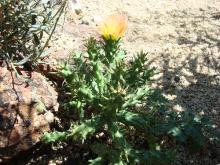
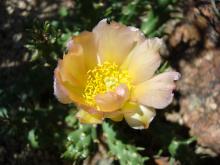
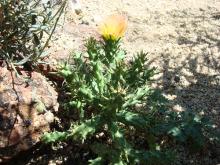
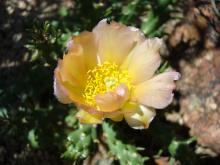

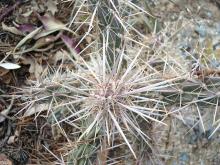
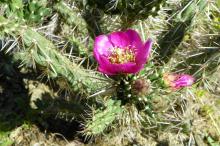
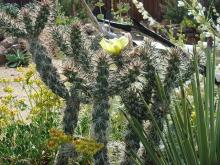
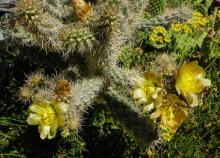
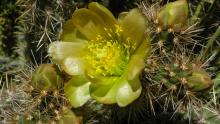

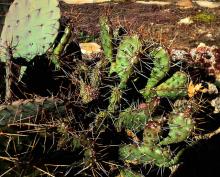
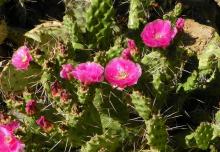
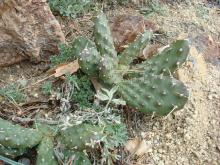
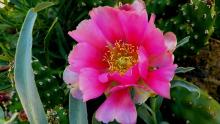
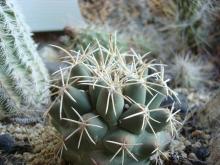
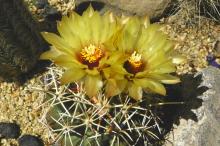
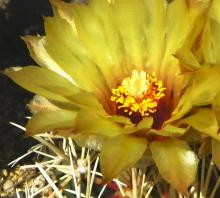
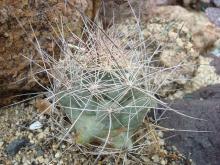
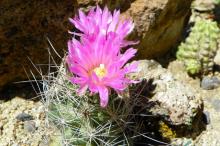
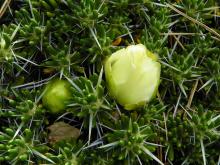
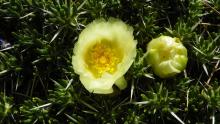
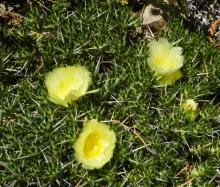
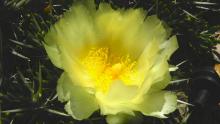
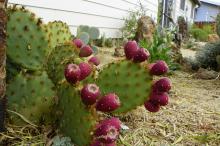

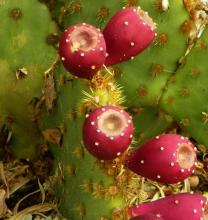
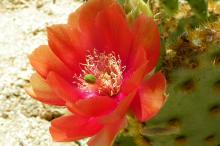
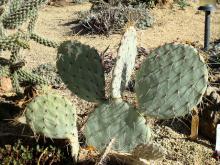
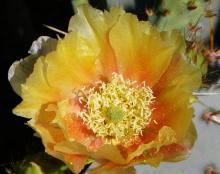
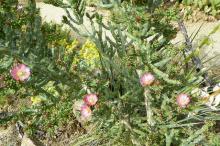
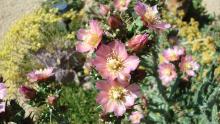
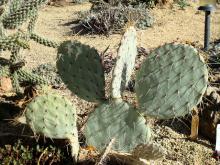
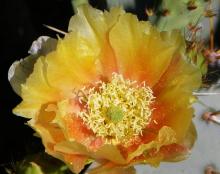
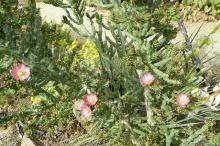
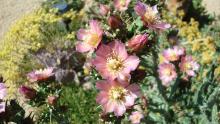
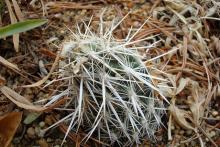
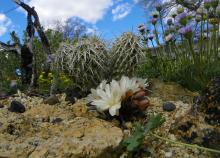
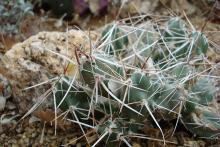
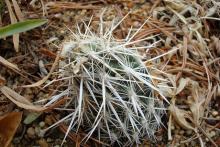
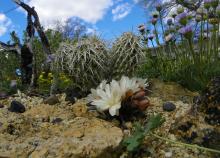

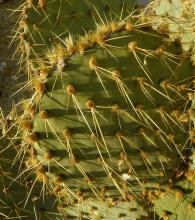
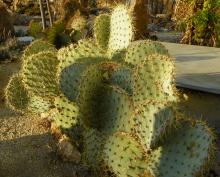
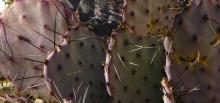
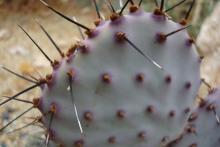
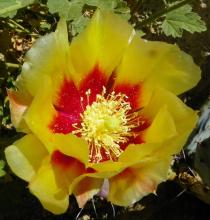
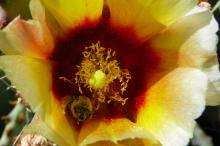
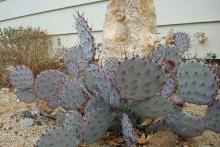
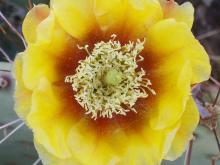
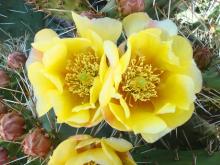
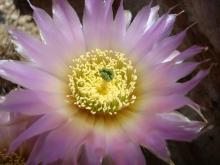
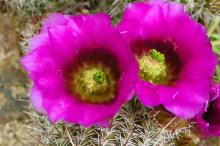
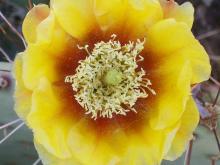

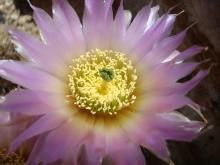
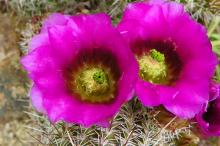


And now, for some really cuddly ones, cylindropuntias all.
First, C. echinocarpa.
Second, the same, with C. imbricata x kleiniae.
Third, C. davisii.
Fourth, C. davisii x leptocaulis.
I like chollas better than tunas, at least in my garden (because they grow up instead of out) but they do get mashed by heavy, wet snow.
Bob